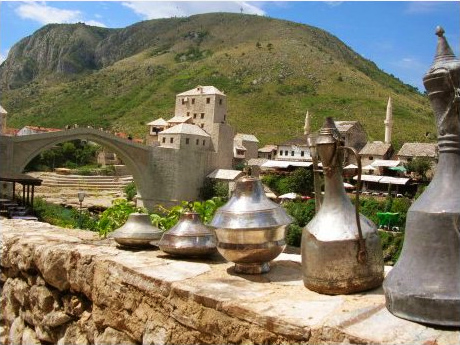 Mostar: handicrafts, in the background the old stone bridge
Mostar: handicrafts, in the background the old stone bridge
Area: 50,197 km2
Population: 4.62 million
Capital: Sarajevo
Official languages: Bosnian, Serbian, Croatian
Currency: Mark
Germans in the history of the region
Bosnia-Herzegovina enjoyed political autonomy only during short periods of its history. In the Middle Ages Bosnia was repeatedly besieged by Hungary and made subject to it. In 1463 Bosnia fell under Ottoman rule and became an integral part of the Ottoman Empire. The local elites and the general population largely assimilated. With the disintegration of Ottoman power the conflicting identities within this region became blurred, first through occupation (1878) and annexation (1908) by Austria-Hungary, and then after 1918 by its integration into the South Slavic Kingdom and later Yugoslavia. With the collapse of the communist regimes, the predominantly sectarian nationalisms came to the surface after the region of Bosnia-Herzegovina became independent in 1992, and led to a destructive war in 1992–1995.
German miners dig for silver
References to Germans can be found in two independent places in the country’s history: First in the 13th to the 15th centuries, when German miners were brought here as well as to Serbia or Hungary mainly for the mining of precious metals. The main towns of the »Saxons« (South Slavic sasi) were Neuenberg (Novo Brdo), Bergsau (Brskovo) or Trepča, and definitely Srebrenica (Silver Town). German mining laws were preserved in the »Kanun sas« even in Ottoman times, but the German settlements disappeared towards the end of the Middle Ages. The last records date from the early modern period.
Second wave of settlements in the 19th century
Later, in the second half of the 19th century, German settlements such as Rudolfsthal and Windthorst were established. In the Ottoman era colonialists had already settled in the vicinity of a German Trappist monastery not far from Banja Luka, reinforced from 1878 after the occupation by Austria-Hungary. From the end of the 1880s, a number of German towns in Drina and Sawe, such as Franzjosefsfeld (Petrovo Polje), were established in the north-east of the country. The vast majority of the settlers came from areas occupied by the so-called Danube Swabians. This was followed by a state-sponsored wave of settlements around 1900, especially in the Bosna River valley, which included, among other things, the creation of twelve German villages with predominantly Russian-German settlers. Finally, German workers' settlements were added to industrial sites. The 1910 census showed about 23,000 Germans in Bosnia-Herzegovina, and a Yugoslav census of 1921 had only 16,500. After severely limited development opportunities during the interwar period, a German-Croatian resettlement agreement was reached in 1942, which led to the transportation of almost all the German inhabitants of Bosnia-Herzegovina, with the exception of four large, mainly enclosed, settlements. After the expulsions and internments in the aftermath of the Second World War, there were just 1,263 Germans counted in the federal state of that name in 1948. Today, individual initiatives, especially from Germany, are trying to preserve testimonies of the German cultural heritage in Bosnia, such as the Catholic Church in Windthorst (Nova Topola).
Literature
Gündisch, Konrad: »Saxones« im Bergbau in Siebenbürgen, Bosnien und Serbien. In: Grimm, Gerhard; Zach, Krista (Hrsg): Die Deutschen in Ostmittel- und Südosteuropa. Bd. 2, München 1996, S. 119-132
german
Bohmann, Alfred: Menschen und Grenzen. Bevölkerung und Nationalitäten in Südosteuropa. Bd. 2, Köln 1969 (vergriffen).
german